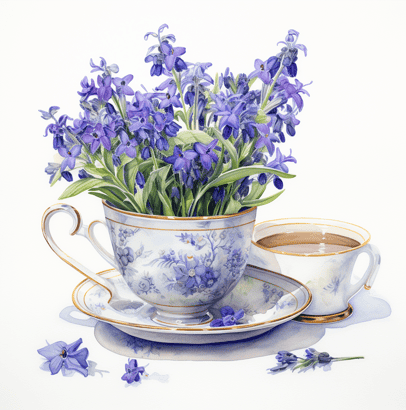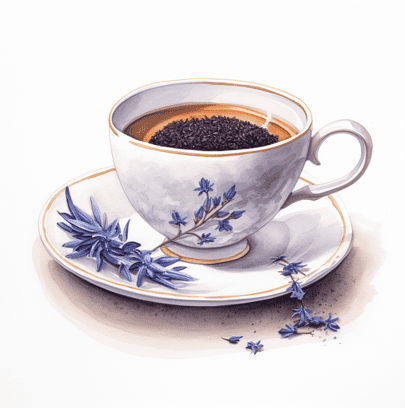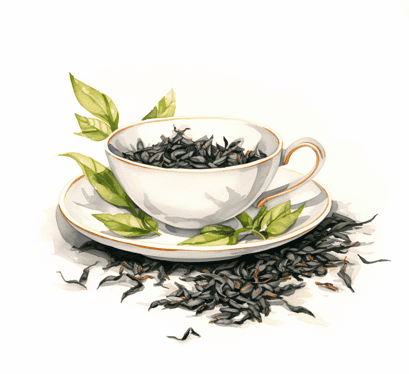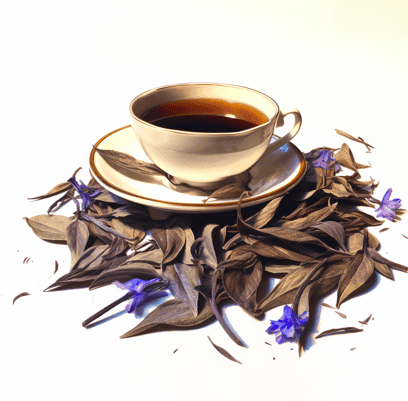
Are you craving a fresh citrusy flavour with your tea. Here we will cover how to make Earl Grey tea in the classic way as well as a couple variations. You’ll also find out what mistake to avoid if you want the most health and beauty benefits.
Hi, I’m Hazel
I gave up on skincare after years of issues with acne and sensitive skin.
But after going plant-based, my skin cleared up and even started to glow. Now I help women reveal their natural beauty with simple, delicious plant-based food.
I also used to be a nurse, and love nerding out on nutritional science (high-quality science, that is).

As usual, this post is based on the strongest nutritional evidence I could find with a focus on the simplest, most delicious foods
…because who has time to waste on actions that don’t work?
The quick version:
To make Earl Grey tea, start by boiling water and letting it slightly cool to about 98°C. Place one teaspoon of Earl Grey tea leaves per cup into a tea strainer, steep for three to five minutes depending on your preferred strength, and remove the leaves. For a classic touch, add a slice of lemon or a splash of plant-based milk.
Earl Grey Tea
Earl Grey tea isn’t just another type of tea; it’s a wellness ritual steeped in history.
This beloved blend of black tea owes its exquisite aroma to the oil of bergamot, extracted from the rind of the bergamot orange which is then added to the loose tea.

This citrus fruit enhances the flavour, but also brings skin-loving benefits, thanks to the oil’s phytonutrients. Imagine sipping your way to stress relief and improved skin health—all from the comfort of your cup!
Should You Put Milk in Earl Grey Tea?
Traditionally, the decision to add milk to Earl Grey tea varies widely.
In some parts of the world, it’s common to enjoy Earl Grey with a splash of milk. This tradition complements the bold flavours of the tea and softens the distinct citrusy notes of the bergamot.
However, in terms of health and beauty it’s important to note that dairy milk binds the antioxidants present in the tea. This reduces their availability to your body and means you won’t fully benefit from the health-promoting properties of the tea.
If you’re inclined to add milk, choose a mild, plant-based option like oat milk or cashew milk. These can offer a creamy texture without overwhelming the natural bergamot flavours and without interfering with the tea’s antioxidants.
Whether you follow tradition with a slice of lemon or personalise it with a splash of milk, Earl Grey remains a versatile choice for both classic and contemporary tea drinkers.
How to Make Earl Grey Tea British Style
When it comes to a British take on Earl Grey tea, it’s all about strength and tradition.
In the UK, Earl Grey is often brewed strong and served with a slice of lemon, enhancing the floral and citrus notes of the bergamot. This method is preferred as it complements the traditional British love for more pronounced flavours in their teas.
You might also like:
How Long Does Black Tea Last? Keeping It Fresh
Ingredients
You’ll need some Earl Grey tea leaves, ideally loose leaf tea for the fullest flavour, and a reliable tea strainer.
Boil some filtered water—the quality of water can truly make or break your tea experience. However don’t use it at boiling temperature. You just want hot water.
If you like your tea creamy, keep some plant-based milk handy. Whether you’re gearing up for a warm perfect cup of Earl Grey tea or a refreshing Earl Grey iced tea, having these basics at your fingertips sets the stage for tea perfection.
You may also like:
Classic Earl Grey Tea Recipe

Ingredients
- Loose leaf Earl Grey tea leaves
- Slice of lemon or a dash of plant-based milk
Instructions
- Boil water to just below boiling point—about 208°F (98°C)—to preserve the delicate flavours of the tea.
- For a stronger cup of Earl Grey, use about one teaspoon of tea leaves per cup. Place the leaves directly into your tea strainer.
- Steep the tea for three to five minutes depending on how strong you like it. The longer it steeps, the more pronounced the black tea flavour becomes and the more antioxidants you will drink!
- If you’re making an Earl Grey milk tea, add a splash of oat milk after steeping.
Note: For an Earl Grey iced tea, let the tea cool before pouring it over ice.
This simple process ensures that each sip of your Earl Grey tea is as delightful and healthful as possible, blending tradition with personal taste.
You may also like:
How is Jasmine Tea Made? (the classic and variations)
Customising Your Earl Grey
The beauty of Earl Grey tea lies in its versatility.
London Fog Latte
For a soothing treat, try whipping up a London fog latte—it’s basically an Earl Grey latte with hint of vanilla added.
Just add steamed plant-based milk and a dash of vanilla syrupto your brewed tea.
Earl Grey Iced Tea
Looking for something cooler?
Make this cold brew tea easily with earl grea tea bags and cold water. Steep the tea bag for an hour, then add a few ice cubes and if you want, a splash of plant-based milk.
Is Earl Grey Tea Healthier than Normal Tea?

Yes, Earl Grey tea can be considered healthier than standard black or green tea.
The secret lies in its signature ingredient, bergamot oil. Extracted from the bergamot peel, this oil contains bergamottin, a phytonutrient known for its health benefits.
These include antioxidant properties and the potential to support skin health, making Earl Grey not just a delightful choice but a beneficial one for your overall well-being.
Conclusion
Dive into the simple pleasure of how to make Earl Grey tea and discover how this elegant brew can align with your health and beauty goals. Whether enjoyed in its classic form or as part of a creamy latte, Earl Grey offers a versatile and enriching addition to your daily routine. Try it today and feel the difference in your wellbeing—your feedback and suggestions for future plant-based recipes or tea variations are always welcome!
References
Most references below will link to the original peer-reviewed study itself. However, sometimes I will link to a video over at NutritionFacts.org instead, which is by far the single best resource of brutally transparent nutritional evidence you will ever see. Dr Greger tells a great story about the realities of the science and if I think you will benefit more from one of his videos, the link will take you there instead.
Happy nerding!
Black Tea vs. Earl Grey at NutritionFacts.org